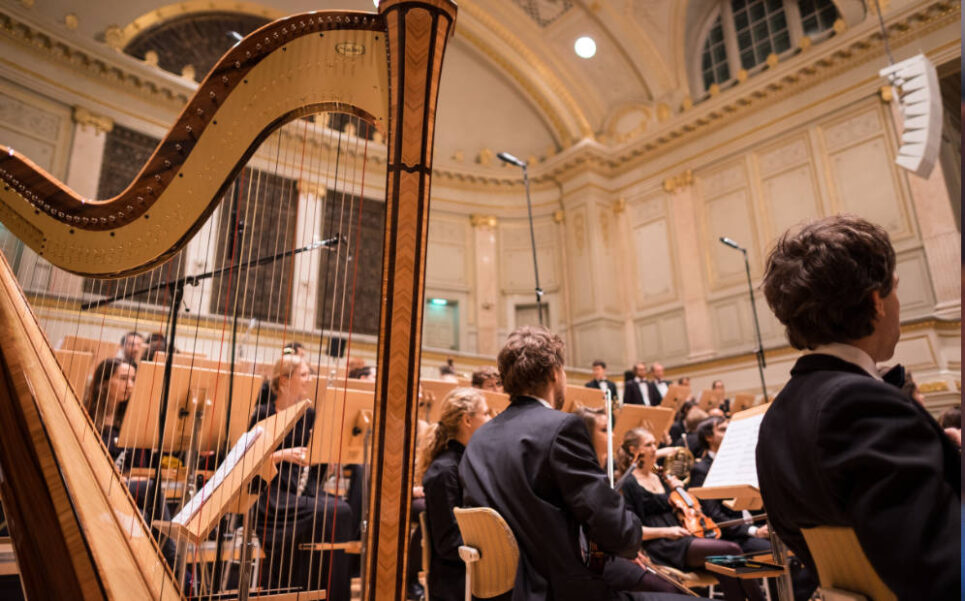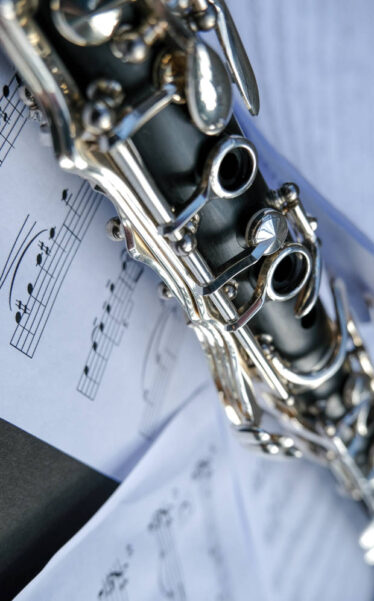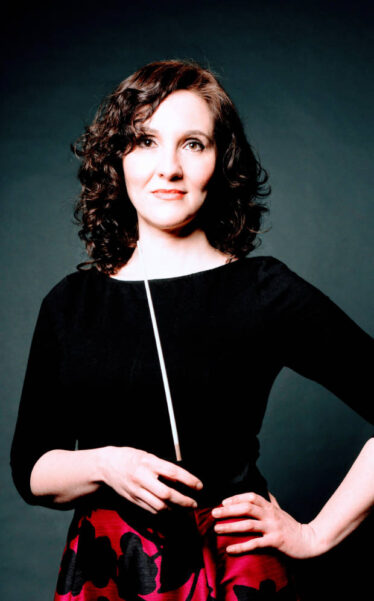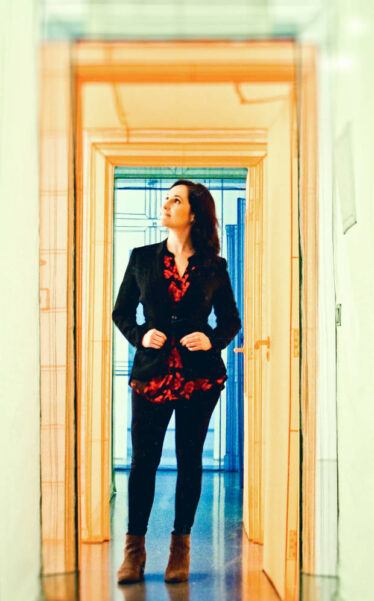Art as we well know has many worlds, many options, and too many expressions. Music is one of the most beautiful artistic expressions.
Within the vast universe of music, we find classical music and within this, there are several parts. One of these parts is an orchestra.

The orchestras are composed of artists who interpret the scores of the compositions and obviously of the conductors.
But, in this specific opportunity, we will talk about the conductors of the orchestras. We will dedicate these words to the female conductors and especially to Mercedes Díaz García.
Situating ourselves
The first thing, as always, is to situate ourselves a little. That is, to have a context.
So, an orchestra is a large musical ensemble, that originated in the baroque period and combines instruments from different families (string, wind, and percussion instruments). There are different types of orchestras.
The full-sized Western orchestra may sometimes be referred to as a symphony orchestra or a philharmonic orchestra. The number of musicians in performance can vary from seventy to over one hundred musicians. This number usually depends on the work being performed and the size of the venue.
A chamber orchestra (sometimes a concert orchestra) is a smaller ensemble of no more than about fifty musicians.
Obviously for the musicians to perform the works properly they need a conductor. The conductor of an orchestra has the primary responsibility of preparing the musical ensemble for public performances. This requires the interpretation of musical works and the real-time communication of those interpretations to the musicians through arm gestures.
The role of the conductor
Let’s start by saying that conducting an orchestra means leading and imprinting one’s personality on the musicians as a whole. The person who conducts is the person who interprets the work. It is the person who understands the essence of the work, inspires, and sets the rhythm. In addition to this, he or she must coordinate and integrate the various instrumental sections.

The conductor shapes the music, making important musical decisions about dynamics, tempo, and balance.
Not only are they great leaders, but the best conductors are also capable of interpreting the same musical work performed countless times in new and illuminating ways.
At a basic level, conducting is very simple. It keeps an orchestra or chorus on time and together.
But that is only the starting point. More importantly, the conductor is the composer’s messenger. It is his responsibility to understand the music and to convey it through gestures so transparently that the musicians in the orchestra understand it perfectly.
Those musicians can then convey a unified vision of the music to the audience.
Women in charge
I think we have been able to establish that the role of the conductor is essential to classical music. So, if the art world is so open to all kinds of performers and is always offering change and breaking new ground, why is the female presence on the conductor’s podium so rare, even in the 21st century?

Let’s establish that our culture, overwhelmingly, is patriarchal. And, mistakenly, it has been taught that orders are given by men and female leadership is still not that common.
They are still very few and most of them are unknown. It is very difficult to see them on stage and it is hard to find them in the networks.
It is surprising the fact that, despite being recognized professionals and being at the top of the world’s management, there is almost no information about them.
So, with this information, we came to Mercedes Diaz Garcia, a Spanish conductor who has been living in Hamburg, Germany for almost 4 years.
She began her musical career studying oboe and piano at an early age and over the years she obtained advanced degrees in both instruments. She also played in orchestras in Spain, Germany, and England and recorded as a soloist for Spanish Television.
She later obtained a teaching position with the Ministry of Education to teach oboe at National Conservatories in Spain and held professorships in Murcia and Madrid.

She left the country many years ago as she traveled to the United States of America and ended up staying for almost a decade. When she left the country, she was working as a conservatory teacher in Spain and resigned to continue her training as a conductor in another country.
Laura Viera A.: Why did you leave the country?
Mercedes Díaz García: I left because I wanted to devote myself to conducting and I did not see any possibilities. I had taken courses in Europe, and I wanted to have the possibility of studying in other places so I went to the United States to train as a conductor and follow my dream.
Art is a part of me. It’s almost who I am. It’s like breathing or eating, it’s a need to make music. – Mercedes Díaz García –
She earned Master’s degrees in Conducting from Bard College, where she studied with Harold Farberman, and the College-Conservatory of Music at the University of Cincinnati, where she studied with Mark Gibson. He earned a doctorate in Contemporary Music from Bowling Green State University, where he studied with Emily Freeman Brown. Other influential conductors have included Kenneth Kiesler, Cliff Colnot, Richard Rosenberg, Jessica Cottis, Edo de Waart, and Paavo Jarvi, among others.
In the United States, she has taught conducting as an assistant professor at Cincinnati College-Conservatory of Music and Bowling Green State University.
She has conducted orchestras in North America, South America, and Europe, participating in festivals such as MIMO in Sao Paulo (Brazil) and The National Music Festival (USA).
Laura Viera A.: How is the world of music in Spain?
Mercedes Díaz García: The truth is that it is a small world. Of course, Spain is neither the United States nor Germany in terms of classical music.
What makes the lack of women even more astonishing is that in other areas of classical music, the balance between women and men is quite equal.
Today, blind auditions have become the norm for orchestras, where candidates play behind screens so that judges cannot be influenced by their gender, race, or appearance.

The argument that not as many women try to become leaders is superfluous and a huge lie. However, outdated prejudices can be found against women taking on leadership roles in classical music.
A perfect example was Russian conductor Vasily Petrenko’s comments made in September 2013 in which he said that orchestras react better when they have a man in front of them and a pretty girl on a podium means that musicians think about other things.’
He defended his comments, claiming that he was referring to the situation of women conductors in Russia and that they were not a reflection of his actual point of view.
Laura Viera A.: From your perspective, what is the role of the woman director like?
Mercedes Díaz García: Things have changed a lot in recent years but there is still a problem of perception. It is a very complicated problem to change. As it is a job where you do not create a sound, but work with the energy of the orchestra, it is much more obvious.
The female energy is more receptive but not weak.- Mercedes Díaz García –
Laura Viera A.: Why is it so reduced (I don’t even know if it is the right word) of women as drivers?
Mercedes Díaz García: It is somewhat complicated but there are several factors. On the one hand, there is the question of power. We can say as a society that we want changes but the truth is that it is not so easy to change. Power wants to stay there. Historically there has been a male power, almost dictatorial for many years and now things are changing little by little. But of course, that kind of power has never been associated with women. Many women who have been in positions of power have had to play by men’s rules. I am not in favor of that because I don’t want to stop being myself and I think there is tremendous strength in femininity. What I hope is that with time, feminine energy will begin to be understood as a powerful energy.
A mystical air
The maestro on the podium is one of the most recognizable figures in classical music, but what exactly is he or she doing up there?
The nature of the conductor has changed over the last millennia, but the mysterious figures on the podium are still surrounded by a certain mystical air.

From a more mundane point of view, we could consider conductors as the musical equivalent of sports team coaches.
You can’t quantify precisely what they do, but you know it when you see it.
For Mercedes, the easiest thing in her entire artistic career has been to dedicate herself to what she is passionate about. One of the most difficult moments has been being away from her family.
Laura Viera A.: Who has inspired you?
Mercedes Díaz García: Many people, not necessarily famous people. For me, it is an inspiration to see kindness and optimism. When I see people around me who want to do things.
Laura Viera A.: What do you need to achieve?
Mercedes Díaz García: Well, I see the world of music and directing as a path and not as goals. So, the road never ends, it always goes forward.
The conductor is there to give life to a musical score, communicating his refined sense of the work through an individual language of gestures.
She made it very clear to me, that young women who want to be conductors must be willing to work very hard. To never give up. They need to know that it is a long and slow but very satisfying road.
Concluding
Classical music is unique among musical forms in that the same works, many of them centuries old, are performed and recorded over and over again, often several times a year.
There is a reason why certain performances linger in the memory. I believe it is largely because of that figure on the podium, who does much more than wave his hands in the air.

A great conductor may have unmatched intuition and musical instincts, but innate musicality will only get you so far. They are cerebral creatures who will usually have spent many hours preparing the score before approaching the podium.
Pleasingly I have found them to be of a very rigorous, even academic nature, and will embrace historical documents such as letters, technical performance manuals of the period in question, and biographies.
The conductor is the expressive heart of the orchestra. A great conductor can achieve something magical. She is art, she is female empowerment, and she is a strong advocate for new music. She is the conductor.


